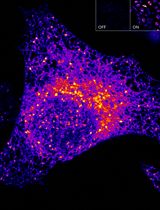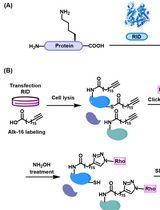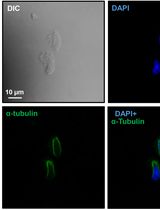- EN - English
- CN - 中文
Wheat Germ Agglutinin (WGA)-SDS-PAGE: A Novel Method for the Detection of O-GlcNAc-modified Proteins by Lectin Affinity Gel Electrophoresis
小麦种子凝集素(WGA)-SDS-PAGE:一种利用凝集素亲和凝胶电泳对O-乙酰氨基葡萄糖修饰蛋白进行检测的新方法
发布: 2018年12月05日第8卷第23期 DOI: 10.21769/BioProtoc.3098 浏览次数: 8889
评审: Alessandro DidonnaRubul MoutJulie Weidner

相关实验方案

高灵敏且可调控的 ATOM 荧光生物传感器:用于检测细胞中蛋白质靶点的亚细胞定位
Harsimranjit Sekhon [...] Stewart N. Loh
2025年03月20日 2156 阅读
Abstract
Diverse cytoplasmic and nuclear proteins dynamically change their molecular functions by O-linked β-N-acetylglucosamine (O-GlcNAc) modification on serine and/or threonine residues. Evaluation of the O-GlcNAcylation level of a specific protein, however, needs multiple and time-consuming steps if using conventional methods (e.g., immune-purification, mass spectrometric analysis). To overcome this drawback, we developed the following easy and rapid method for detection of O-GlcNAcylated proteins of interest. An O-GlcNAc affinity gel layer containing wheat germ agglutinin (WGA), a GlcNAc-specific lectin, selectively induces retardation of the mobility of O-GlcNAcylated proteins during electrophoresis. This WGA-layer thereby separates O-GlcNAcylated and non-modified forms of proteins, allowing the detection and quantification of the O-GlcNAcylation level of these proteins. This new method therefore provides qualitative and quantitative analysis of O-GlcNAcylated proteins in a relatively shorter time compared to conventional methods.
Keywords: O-GlcNAcylation (O-乙酰氨基葡萄糖)Background
O-linked β-N-acetyl-glucosamine modification (O-GlcNAcylation) is one of the known protein post-translational modifications (PTMs) that regulate various properties of proteins such as their stability, subcellular localization, and catalytic activity. O-GlcNAcylation is the result of a reaction in which a single-sugar, N-acetylglucosamine (GlcNAc), is conjugated to the hydroxyl moiety of a serine or a threonine residue of cytoplasmic and nuclear proteins, thereby dramatically altering the molecular functions of these proteins (Yang and Qian, 2017). O-GlcNAcylation is dynamically and reversibly regulated by only two enzymes: O-GlcNAc transferase (OGT) and O-GlcNAcase (OGA) (Hanover et al., 2012; Ruan et al., 2013). OGT catalyzes the addition of a GlcNAc moiety from a uridine diphosphate (UDP)-GlcNAc to target proteins, while OGA removes O-GlcNAc from the modified proteins. Since both O-GlcNAcylation and phosphorylation occur at serine and threonine residues, these two types of PTMs are mutually exclusive on the same target site. Indeed, various cellular proteins have been demonstrated to show dynamic crosstalk between O-GlcNAcylation and phosphorylation (Hu et al., 2010). Despite advances in understanding the importance of O-GlcNAcylation in diverse physiological processes, stoichiometric analysis of only a few O-GlcNAc proteins has been reported. The main reasons for such few reports are the high cost and the time-consuming processes required by conventional methods for quantification of protein O-GlcNAcylation (Rexach et al., 2010; Shen et al., 2012). In addition, the O-GlcNAc moiety tends to be released from the modified peptide in collision-induced dissociation (CID) in mass-spectrometric analysis (Chalkley et al., 2001), which limits evaluation of the O-GlcNAcylation level of a specific protein by using this method. Hence, the development of novel methods for quantitative analysis of protein O-GlcNAcylation remains an important challenge.
To overcome this drawback, we have established a novel technique for the separation of cellular O-GlcNAcylated proteins by incorporating wheat germ agglutinin (WGA), a lectin from Triticum vulgaris, into an electrophoretic gel (Aub et al., 1965). WGA has multiple GlcNAc-binding sites (Wright, 1987 and 1992), and the dimerized form of this protein is highly resistant to protein denaturing conditions including acidic environments, chaotropic agents, and high temperature (Rodríguez-Romero et al., 1989; Chavelas et al., 2004). In addition, WGA has been used as an effective tool for the analysis and purification of O-GlcNAc proteins. For example, horseradish peroxidase (HRP)-conjugated WGA can be utilized as a probe to detect O-GlcNAcylated proteins in Western blotting analysis, and a WGA-agarose column can be used for the purification of O-GlcNAcylated proteins from cell extracts (Zachara et al., 2011). Here, we describe a new electrophoretic method, termed WGA-SDS-PAGE, that separates O-GlcNAcylated and unmodified proteins, thereby allowing the detection and quantification of O-GlcNAcylated proteins (Figure 1) (Kubota et al., 2017).
Figure 1. Schematic of the principle of WGA-SDS-PAGE. A whole cell lysate contains proteins with different O-GlcNAcylation levels. As the O-GlcNAcylated proteins pass through the WGA-copolymerized acrylamide gel layer, their migration is retarded depending on their O-GlcNAc level because the O-GlcNAc residues interact with the immobilized-WGA. Thus, the higher the O-GlcNAc level of the modified protein, the slower it migrates in the subsequent separating gel.
Materials and Reagents
- Microcentrifuge tubes (FCR&Bio, catalog number: MPF-150C)
- Disposable pipettes (VWR, catalog number: 89130-396-898/900)
- Tips (BMBio, catalog numbers: BIO1000RF, BMT-200LYRS)
- 15 ml and 50 ml conical tubes (VIOLAMO, catalog numbers: 1-3500-21, 1-3500-22)
- Cell scraper (NIPPON Genetics, catalog number: TR9000)
- 35 mm cell culture dishes (Thermo Scientific, catalog number: 130180)
- Whatman cellulose chromatography papers 3MM Chr sheets (Whatman, catalog number: 3030-917)
- Amersham Protran Premium 0.45 NC nitrocellulose Western blotting membranes (GE Healthcare, catalog number: 10600034)
- Protein G-sepharose beads (GE Healthcare, catalog number: 17061801)
- Paper towel (Elleair, catalog number: 703153)
- Filter paper
- HEK293 cells (ATCC, catalog number: CRL-1573)
- Anti-HA antibody (Santa Cruz, catalog number: sc-7392)
- Anti-Myc antibody (Santa Cruz, catalog number: sc-40)
- Anti-Flag antibody (Sigma, catalog number: F1804)
- Anti-GlcNAc antibody (Santa Cruz, catalog number: RL2, sc-59624)
- Anti-Actin antibody (Wako, catalog number: 013-24553)
- Anti-OGT antibody (Abcam, catalog number: ab96718)
- Anti-Nup62 antibody (Santa Cruz, catalog number: sc-25523)
- Anti-AGFG1 (Arf-GAP domain and FG repeat-containing protein 1) antibody (Abcam, catalog number: ab86349)
- HRP-conjugated secondary antibodies
Anti-mouse (GE Healthcare, catalog number: NA931-1 ml)
Anti-rabbit (GE Healthcare, catalog number: NA934-1 ml) - Sodium deoxycholate (DOC) (Sigma, catalog number: D6750)
- O-(2-Acetamido-2-deoxy-D-glucopyranosylidenamino) N-phenylcarbamate (PUGNAc) (Sigma, catalog number: A7229)
- Thiamet-G (TMG) (Cayman, catalog number: 13237)
- Phenylmethylsulfonyl Fluoride (PMSF) (NACALAI TESQUE, catalog number: 27327-94)
- Aprotinin from Bovine Lung (NACALAI TESQUE, catalog number: 03346-84)
- Leupeptin Hemisulfate (NACALAI TESQUE, catalog number: 20454-76)
- Phosphate Buffered Saline (PBS) (10x) (pH 7.4) (NACALAI TESQUE, catalog number: 27575-31)
- Ammonium peroxodisulfate (APS) (Wako, catalog number: 012-20503)
- N,N,N',N'-Tetramethylethylenediamine (TEMED) (NACALAI TESQUE, catalog number: 205-06313)
- 2-Butanol (s-Butyl Alcohol) (NACALAI TESQUE, catalog number: 06101-55)
- Skim milk powder (Wako, catalog number: 190-12865)
- Bio-Rad Protein Assay Dye Reagent Concentrate (Bio-Rad Laboratories, catalog number: 5000006ja)
- DMEM (1.0 g/L Glucose) with L-Gln and Sodium Pyruvate, liquid (NACALAI TESQUE, catalog number: 08456-65)
- 200 mM L-Glutamine Stock Solution (NACALAI TESQUE, catalog number: 16948-04)
- Penicillin-Streptomycin Mixed Solution (100-fold concentrated stock) (NACALAI TESQUE, catalog number: 09367-34)
- WGA protein (J-OIL MILLs, catalog number: J120)
- Enhanced chemiluminescence (ECL) Western Blotting Detection Reagents (GE Healthcare, catalog number: RPN2109)
- ECL prime Western Blotting Detection Reagent (GE Healthcare, catalog number: RPN2232)
- Albumin, Bovine Serum, Globulin Free (Bovine Serum Albumin) (BSA) (NACALAI TESQUE, catalog number: 01281-84)
- Pre-stained Protein Markers (Broad Range) for SDS-PAGE (NACALAI TESQUE, catalog number: 02525-35)
- HRP-Conjugated Succinyl WGA (sWGA) (EY-laboratories, catalog number: H-2102-1)
- 2-Amino-2-hydroxymethyl-1,3-propanediol 999 (Tris) (Wako, catalog number: 011-16381)
- Hydrochloric Acid (HCl) (35%) (NACALAI TESQUE, catalog number: 18321-05)
- Ethylenediamine-N,N,N',N'-tetraacetic acid, disodium salt, dehydrate (EDTA) (Dojindo, catalog number: N001)
- Sodium Chloride (NaCl) (NACALAI TESQUE, catalog number: 31320-05)
- Triton X-100 (NACALAI TESQUE, catalog number: 35501-15)
- Glycerol (NACALAI TESQUE, catalog number: 17018-83)
- 2-Mercaptoethanol (NACALAI TESQUE, catalog number: 21438-82)
- Sodium dodecyl sulfate (SDS) (NACALAI TESQUE, catalog number: 31606-75)
- Bromophenol blue (BPB) (NACALAI TESQUE, catalog number: 05808-61)
- Glycine (NACALAI TESQUE, catalog number: 17109-64)
- Methanol (NACALAI TESQUE, catalog number: 21915-93)
- Polyoxyethylene Sorbitan Monolaurate (Tween-20) (NACALAI TESQUE, catalog number: 35624-15)
- 30% (w/v)-Acrylamide/Bis Mixed Solution (37.5:1) (NACALAI TESQUE, catalog number: 06144-05)
- X-tremeGENE 9 DNA transfection reagent (Sigma, catalog number: 06365809001)
- FCS
- Stock cell lysis buffer (see Recipes)
- 5x SDS-PAGE loading buffer (see Recipes)
- Stock Separating gel buffer (see Recipes)
- Stock Stacking gel buffer (see Recipes)
- Transfer buffer (see Recipes)
- 10x Running buffer for electrophoresis (see Recipes)
- TBST (see Recipes)
- Primary antibody solution (see Recipes)
- Secondary antibody solution (see Recipes)
Equipment
- P1000, P200, and P20 pipettes (Gilson, catalog numbers: F123602, F123601, F123600)
- Glass plates for electrophoresis (Nihon-Eido, catalog numbers: NA-1000-3, NA-1000-4)
- Clips (Nihon-Eido, catalog number: NA-1000-15)
- Gel comb (Biocraft, catalog number: NO-MC141)
- Cell culture incubator (Panasonic, model: MCO-19AIC)
- Freezer (Panasonic, model: MDF-U700VX)
- Vortex mixer (M&S Instruments, model: VORTEX-GENIE 2 Mixer)
- Desktop shaker (TAITEC, model: Wave-SI)
- PowerPac Universal Power Supply (Bio-Rad Laboratories, catalog number: 1645070JA)
- Transfer devices for electrotransfer of proteins in a polyacrylamide gel (Biocraft, catalog number: BE350)
- Mini-type electrophoresis apparatus (gel thickness, 1 mm; Nihon-Eido)
- Micro Refrigerated Centrifuge (KUBOTA, model: 3740)
- Digital systems for imaging and analyzing Western blotting (FUJIFILM, model: LAS-1000 Plus and Image Gauge)
- Rotator (EYELA, model: MBS-1)
Procedure
文章信息
版权信息
© 2018 The Authors; exclusive licensee Bio-protocol LLC.
如何引用
Fujioka, K., Kubota, Y. and Takekawa, M. (2018). Wheat Germ Agglutinin (WGA)-SDS-PAGE: A Novel Method for the Detection of O-GlcNAc-modified Proteins by Lectin Affinity Gel Electrophoresis. Bio-protocol 8(23): e3098. DOI: 10.21769/BioProtoc.3098.
分类
生物化学 > 蛋白质 > 翻译后修饰
分子生物学 > 蛋白质 > 检测
您对这篇实验方法有问题吗?
在此处发布您的问题,我们将邀请本文作者来回答。同时,我们会将您的问题发布到Bio-protocol Exchange,以便寻求社区成员的帮助。
Share
Bluesky
X
Copy link











